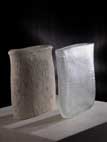-
-
ďThere are doubtless fears
of various types associated with going beyond certain taboos when we are
dealing with themes such as spirituality, religion, the area of the
soul. It is the fear of losing control. And yet it is only when you
abandon your self-control that you arrive at new forms of vision. In
fact, when fear of the unknown makes room for confidence, then change
and innovation are possible.Ē
-
In an era such as our own, where we are constantly faced with infinite
transitions, we are often tempted to wonder if it isnít possible to
codify the different phenomenologies of contemporary art in a sort of
cinematic ritual that would make it comprehensible in its totality, in
its unitary globality.
If we start with the concept that all art (and not only art) is matter,
then it is only natural to reflect on whether it is right to bring
matter back to a level that transmits pure energy. All this derives from
the fact that, alongside the external world, there is also an interior
world. As there are always two sides to every coin, we would therefore
have find the right, but certain, balance. And man, dealing with art,
has, as it were, the possibility to re-design his own role, along with
his limits and boundaries.
The meaning of all this lies in the fact that art, metaphorically,
reveals itself as a travel companion able to accompany us towards new
dimensions of life. It asks us questions about which and how many
resources we are harbouring, about what we are able to mobilise in order
to reach new horizons. If we want to undertake this journey, we need
bridges. And Art is one of these: it allows us to get to the other side,
it leads us back to a situation which is in any case consubstantial with
man. A situation in which thought begins once again to logically
restructure a new grammar and language. New in the sense of re-found.
All contemporary art, in fact, is nothing other than a reflection of the
idea or philosophy of a transversal, complex and at times even
incomprehensible (if superficially interrogated) cultural era. This is
why it seems ever more willing to provide innovative spatial dimensions,
new temporal dynamics. It attempts to represent the interior world of
man. It simulates the feelings, sensations, emotions that he would be
experiencing if he were faced with his own thoughts and wanted to
completely traverse these thoughts.
|
A work of
art is thus the end result of a specific process Ė possessing a specific
form and aesthetic, it serves no purpose except that of channelling a
very specific form of energy. It is always a sort of communicative
performance. It allows man to plumb his own conscience and to void it.
In fact, it is only within empty spaces that energy is able to unleash
its own creative force. Consequently, by asking how to develop this
energy in the face of the complexity of the world, questioning the need
for free mental space, man is experiencing a journey where reality and
the virtual go hand in hand: two dimensions which are no longer
disjoined, in that the virtual is nothing other than an ďas-ifĒ reality.
Now, the contents aspect of any work of art lie in the presupposition
that the artist is in fact able to explain the most concealed of manís
movements and desires. Once this clarity has been acquired, the artist
can purposefully use the talent he has been given. His raw material will
always be the conscious awareness of his own energy, his mental
resources. His aim will therefore be to develop forms where his energy
can be liberated and from which, at the same time, he will receive new
energy. In fact, the artist is nothing other than someone who gives form
to something. He shapes new images for values and then speaks of form
once again. His is a continuous process as he is constantly
interrogating himself on what is really important in his life.
Regardless of the variety and multiplicity of his products (whether they
are beautiful, ugly, weak, strong, sensual, cold), he none the less
follows an extremely progressive path: energy always needs direction,
otherwise it is lost. If the artist didnít have any energy, he would not
be able to define any form for himself, that is no behavioural form, and
he would thus lose his own energy. All of this, however, provided he
doesnít undertake this as an act of will; if he did, then he would
inevitably sacrifice his own happiness.
Considering what we have just said, this volume would therefore like to
present and promote the understanding of just how important it is to go
from an artistís notoriety to the importance of his work, in an attempt
to bring together different experiences within a possible product level,
trying to create a tangible, and an equally subtle and ineffable, link
between these.
If art is put forward as the locus of communication, then it is also the
locus of self-reflection, in that everything is inevitably related to
everything and everyone.
Andrea Pagnez,
curator, writer,
ARTIST
|

